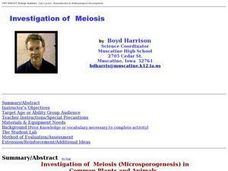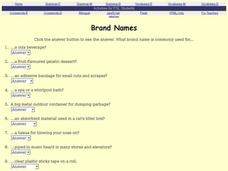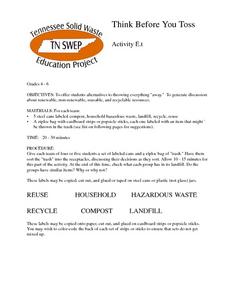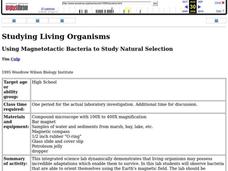Curated OER
Hubble Space Telescope
Students investigate the history and use of the Hubble Space Telescope. They take a quiz in order to establish in any prior knowledge. Students conduct research to find information in conjunction with participating in class discussion...
Curated OER
Particle Depostition Lab
Middle schoolers collect, study and observe the pollution in our air. They list three kinds of pollution that they think is in our air. Students comprehend that the atmosphere is almost completely made up of invisible gaseous...
Curated OER
Naked to the Eye
Sixth graders conduct a variety of experiments that enable them to investigate bacteria. They use microscopes, prepared slides, video, moldy bread and pond water to observe types of bacteria and how bacteria interacts with the...
Curated OER
Air Pollution: Visible and Invisible
Fourth graders work together to complete an experiment on air pollution. They identify visible and invisible forms of pollution. They gather their data in notebooks and analyze their results to end the lesson.
Curated OER
Indoor Air: What's the Matter?
Young scholars investigate the variety and amount of particulate matter in the air. They locate the general sources of pollution for a specific area and develop some suggestions for improving air quality.
Curated OER
Investigation of Meiosis in Common Plants and Animals
Students witness various stages of mitosis through preparing onion root tip slides. With teacher guidance, they learn a great deal through the hands-on process of preparing the slides themselves.
Curated OER
Electrophoretic Analysis: DNA Fingerprinting and Evolutionary Divergence
Young scholars examine the principles of electrophoresis. They evaluate both the agarose and polyacrylamide system of molecular separation. In order to bring the concepts of genetics and evolution full circle from DNA to protein,...
Curated OER
Fossil Impressions of Ancient Life
Students make a mold using Plaster of Paris and then make a cast using that same mold. They pick a fossil and describe how it looks. They write a fictionalized story about its life, or burial. (
Curated OER
Rusting as a Chemical Reaction
Learners participate in a hands-on activity in which they observe conditions that are most conducive to the rusting of iron. They set up an experiment with 8 different nails in different situations with one of them acting as a control....
Curated OER
Plant and Animal Communities
Second graders discuss the six main classes of animals: insects, birds, fish, mammals, amphibians, and reptiles. They complete a variety of activities about animals. They solve animal riddles, categorize toy animals, create an animal...
Curated OER
The Exceptional Nature of Cellulose
Students observe the affects of a substance's composition and structure have on its solubility. In this cellulose lesson plan students compare the amount of energy required to dissolve mono-saccharides with that required to dissolve...
Curated OER
Animal Tracks
Sixth graders practice using logic and scientific proof while examining animal tracks. In this scientific method lesson, 6th graders identify different animals and the type of tracks they leave behind by observing photographs. Students...
Curated OER
Brand Names
In this brand names worksheet, students write the brand names that are commonly used for the items sold. Students complete 11 problems.
Write.com
Abbreviations, Acronyms, and Initialisms
Pupils change words or phrases into the correct abbreviation, acronym or initialism in ten sample sentences. After rewriting the word or phrase, they must identify whether it is an abbreviation, acronym or initialism. For example, pupils...
Curated OER
Particulate Matter: How Dirty is the Air We Breathe?
Fourth graders create a simple testing device and collect and observe the pollution in the air we breathe.
Curated OER
Particulate Matter: How Dirty is the Air We Breathe?
Fourth graders work together to collect air samples for testing. They determine the amount of pollution in the air in their community. They discuss their results to end the lesson.
Curated OER
Hubble Space Telescope
Young scholars investigate the universe through the eyes of the Hubble space telescope. They conduct research from looking at the universe that is simulated with a digital projector. The images are projected onto the wall in a simulation...
Curated OER
Think Before You Toss
Students sort a variety of trash items and determine thier sorting decisions.
Curated OER
Indoor Air: What's the Matter?
Students develop a greater awareness of the variety and amount of particulate matter in the air. They try to locate general sources of pollution for a specific area and develop some suggestions for improving air quality.
Curated OER
It's All in the Air
Young scholars examine air quality. They test the air for visible pollutants by observing jars for one week and compare and contrast the data they collect. After comparing and contrasting the data, they graph the results of pollution...
Curated OER
Using Magnetotactic Bacteria to Study Natural Selection
Students demonstrate that living organisms may possess incredible adaptations which enable them to survive. They observe bacteria that are able to orient themselves using the Earth's magnetic field and formulate a hypothesis as to how...
Curated OER
Air Pollution: Visible And Invisible
Fourth graders observe air pollution that is visible and invisible with experimentation. During the experiment the students collect data that needs analysis. The observations are recorded in the lab journal. The data also is represented...
Curated OER
Earth's Weather
Seventh graders learn how solar radiation, latitude, and other factors affect weather. They break into six groups and are assigned a topic to research and to present their findings orally.
Curated OER
Genes and Aging
Students explore genes and the way we age. They assemble a worm collection device called a Baermann Funnel. Students collect Caenorhabditis elegans or other active nematodes from local soil samples. They observe the appearance and...

























